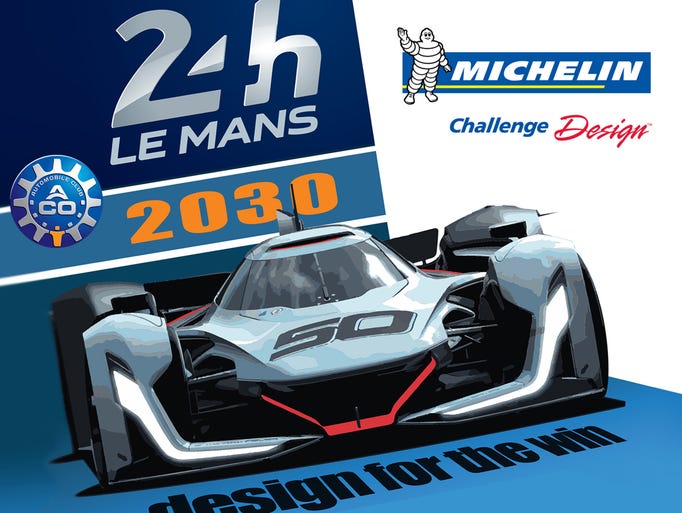Payne: What will race cars look like in 2030?
Posted by hpayne on April 26, 2016

What will race cars look like in 2030? Will they be remote-control driven drones? Will they drive upside down through super loops? Will they run on hydrogen?
The prestigious Michelin Challenge Design wants to know.
So at the Detroit Athletic Club this week, award organizers picked auto racing as its 2017 design theme. Not just any form of racing, but the world’s most famous race, the 24 Hours of LeMans in France. For nearly a century LeMans has been at the cutting edge of auto design thanks to its unique demands of speed, durability and efficiency. It’s attracted the world’s top automakers — Audi, Porsche, Ford, Chevrolet, Ferrari — testing the latest materials, power trains and aero tricks that give them a competitive edge, not just on the track but also in the showroom.
Challenge Design, now in its 15th year, promises thousands of breathtaking entries, pushing the envelope on everything from fuels to autonomy. But if history is any guide, 2030 race cars will look a lot like they do today.
For all its tech savvy, racing is still a commercially-driven, spectator sport. And spectators want to see the best man (or woman) win. That means design will continue to be dictated by rules that 1) promote competition 2) keep costs down and 3) prioritize entertainment.
Promote competition: “My favorite LeMans car is still the Porsche 917,” said Acura Creative Director Dave Marek at Michelin’s event — referring to the gorgeous, 12-cylinder missiles that dominated the 1971 race. With top speeds in excess of 220 mph, the 917 set records for distance traveled that would last for decades.
Its record stood because the car’s dominance forced rule changes for 1972. The fan’s thirst for competition must be slaked. The 4.9-liter 917 was banned — replaced by 3.0-liter, prototype-class cars that allowed more manufacturers a look in at the winner’s circle. Forty-four years (and more rule changes) later, and a hybrid gas-electric Porsche’s 919 won the 2015 LeMans. Yet despite its advanced drivetrain and carbon-fiber chassis, the 919 and 917 look similar — same narrow greenhouse, same long, aerodynamic shape, same rear wing. The laws of physics don’t change.
Keep costs down: Not just physics, but cost must be respected as well. Porsche’s 919 drivetrain is the competitive — and political — engine of choice in endurance racing. Ten years ago, it was diesel as LeMans-winner Audi made the euro tax-favored engines sexy as well as politically correct. But politics is a fickle mistress. “The regulations will define what happens in the race,” said race designer Ben Bowlby at the DAC.
Today, governments favor batteries over diesels. But electrics are expensive, which favors big spenders. Which squeezes competition. Witness Mercedes’ dominance (yawn) of hybridized Formula One.
Will alternative fuels dominate in 2030? Consider that Lemans’ most competitive class — production-based Grand Touring — forbids hybrids to reduce costs. Which means that when Marek’s hybrid supercar Acura NSX enters endurance racing next year it will do so with a gas engine.
Prioritize entertainment: Connectivity and autonomy are the buzzwords of the future.
“Warfare today is conducted with no people,” said Doug Fehan, Corvette’s legendary racing chief. “Does safety become such an element that a decision is made that it’s too dangerous to have humans involved?” Will it mean drones? Virtual racing?
Not likely. The trend in racing entertainment is toward more — not less — driver involvement. Case in point: Daytona. The world-famous race track — which hosts both the LeMans-like 24 Hours of Daytona and NASCAR’s 500 — debuted a $400 million main grandstand “sports megaplex.” Its design gives fans a better front row seat so they can see, hear and interact with their favorite drivers pounding around the track in deafening V-8s.
In a world of multiple sports fan experiences, auto racing offers a unique visceral experience. Like the NFL, the NBA and Major League Baseball, fans demand sportsmen and women over technology. Baseball still uses a wooden bat to level the playing field between pitcher and batter.
Michelin Challenge Design entrants (tune in this fall for winners) will be tempted to gorge on tech, but the truly futuristic entries will dumb-down technology to favor driver parity.
LeMans has its own innovation award called Garage 56, which has produced marvels like the Delta Wing. For 2017 its winning technology that will allow quadruple amputee Frederick Sausset to race. But the car he will pilot — a Morgan prototype — will feature a highly regulated, normally-aspirated, gas-powered V-8 to limit costs and encourage competition.
Because while we love cars — we really care about the human on the winner’s stand at the end.


